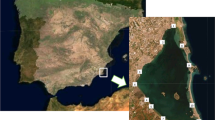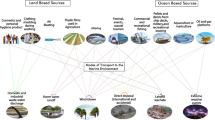Abstract
Pyrethroids are highly toxic towards aquatic macroinvertebrates such as Daphnia magna and can be synergized when co-occurring with azole fungicides. A sensitive analytical method for the measurement of azole-pyrethroid mixtures in aquatic macroinvertebrates is not available at present. We developed and validated an extraction, cleanup, and quantification procedure for four pyrethroid insecticides and four azole fungicides at the picograms per milligram wet weight level in D. magna using a QuEChERS approach and GC-ECD analysis. Short- and long-term matrix effects were analyzed by injection of a series of extracts from D. magna, and the best surrogate standards were identified through correlation analysis of analyte responses. The presence of matrix clearly stabilized the analyte responses (≤6 % relative standard deviation of peak area compared to up to 22 % when injected without matrix). The sensitivity was high with detection limits and limits of quantification between 58–168 and 119–571 pg mg(wet weight)−1 for the azoles and 5.8–27 and 12–84 pg mg(wet weight)−1 for the pyrethroids, respectively. Accuracy (% recovery) was between 95 and 111 % and the precision (repeatability) below 10 % relative standard deviation for all analytes. In the case of prochloraz, α-cypermethrin, and deltamethrin, normalization to surrogate standards led to a clear improvement of accuracy and precision by up to 8 and 4 %, respectively. The method was successfully applied to the measurement of internal α-cypermethrin concentrations in D. magna under environmentally relevant exposure conditions (exposure to a pulse in the micrograms per liter range) with and without co-exposure to propiconazole.

Measurement of pyrethroid and azole pesticides in D. magna after exposure to pyrethroid-azole mixtures applying QuEChERS and GC-ECD




Similar content being viewed by others
References
Bjergager M-BA, Hanson ML, Solomon KR, Cedergreen N (2012) Synergy between prochloraz and esfenvalerate in Daphnia magna from acute and subchronic exposures in the laboratory and microcosms. Aquat Toxicol 110–111:17–24. doi:10.1016/j.aquatox.2011.12.001
Kretschmann A, Gottardi M, Dalhoff K, Cedergreen N (2015) The synergistic potential of the azole fungicides prochloraz and propiconazole toward a short α-cypermethrin pulse increases over time in Daphnia magna. Aquat Toxicol 162:94–101. doi:10.1016/j.aquatox.2015.02.011
LeDoux L (2011) Analytical methods applied to the determination of pesticide residues in foods of animal origin. A review of the past two decades. J Chromatogr A 1218(8):1021–1036. doi:10.1016/j.chroma.2010.12.097
Moschet C, Wittmer I, Simovic J, Junghans M, Piazzoli A, Singer H, Stamm C, Leu C, Hollender J (2014) How a complete pesticide screening changes the assessment of surface water quality. Environ Sci Technol 48(10):5423–5432. doi:10.1021/es500371t
Moschet C, Vermeirssen ELM, Seiz R, Pfefferli H, Hollender J (2014) Picogram per liter detections of pyrethroids and organophosphates in surface waters using passive sampling. Water Res 66:411–422. doi:10.1016/j.watres.2014.08.032
Hladik ML, Smalling KL, Kuivila KM (2009) Methods of analysis—determination of pyrethroid insecticides in water and sediment using gas chromatography/mass spectrometry. US Geological Survey Techniques and Methods 5-C2
Lambert O, Piroux M, Puyo S, Thorin C, L’Hostis M, Wiest L, Buleté A, Delbac F, Pouliquen H (2013) Widespread occurrence of chemical residues in beehive matrices from Apiaries located in different landscapes of Western France. PLoS ONE 8(6), e67007. doi:10.1371/journal.pone.0067007
Styrishave B, Hartnik T, Christensen P, Andersen O, Jensen J (2010) Influence of soil type and organic matter content on the bioavailability, accumulation, and toxicity of α-cypermethrin in the springtail Folsomia candida. Environ Toxicol Chem 29(5):1084–1090. doi:10.1002/etc.127
Harwood AD, You J, Lydy MJ (2009) Temperature as a toxicity identification evaluation tool for pyrethroid insecticides: toxicokinetic confirmation. Environ Toxicol Chem 28(5):1051–1058. doi:10.1897/08-291.1
Erney DR, Gillespie AM, Gilvydis DM, Poole CF (1993) Explanation of the matrix-induced chromatographic response enhancement of organophosphorus pesticides during open tubular column gas chromatography with splitless or hot on-column injection and flame photometric detection. J Chromatogr A 638(1):57–63. doi:10.1016/0021-9673(93)85007-T
The Pesticide Properties DataBase (PPDB) developed by the Agriculture & Environment Research Unit (AERU), University of Hertfordshire 2006–2013. (2013)
Wilkowska A, Biziuk M (2011) Determination of pesticide residues in food matrices using the QuEChERS methodology. Food Chem 125(3):803–812. doi:10.1016/j.foodchem.2010.09.094
Bruzzoniti M, Checchini L, De Carlo R, Orlandini S, Rivoira L, Del Bubba M (2014) QuEChERS sample preparation for the determination of pesticides and other organic residues in environmental matrices: a critical review. Anal Bioanal Chem 406(17):4089–4116. doi:10.1007/s00216-014-7798-4
Omar N, Bakar J, Muhammad K (2013) Determination of organochlorine pesticides in shrimp by gas chromatography–mass spectrometry using a modified QuEChERS approach. Food Control 34(2):318–322. doi:10.1016/j.foodcont.2013.04.029
Lehotay SJ, Mastovská K, Yun SJ (2005) Evaluation of two fast and easy methods for pesticide residue analysis in fatty food matrixes. J AOAC Int 88(2):630–638
Anastassiades M, Lehotay SJ, Stajnbaher D, Schenck FJ (2003) Fast and easy multiresidue method employing acetonitrile extraction/partitioning and “dispersive solid-phase extraction” for the determination of pesticide residues in produce. J AOAC Int 86(2):412–431
Cunha SC, Lehotay SJ, Mastovska K, Fernandes JO, Beatriz M, Oliveira PP (2007) Evaluation of the QuEChERS sample preparation approach for the analysis of pesticide residues in olives. J Sep Sci 30(4):620–632. doi:10.1002/jssc.200600410
Berlioz-Barbier A, Buleté A, Faburé J, Garric J, Cren-Olivé C, Vulliet E (2014) Multi-residue analysis of emerging pollutants in benthic invertebrates by modified micro-quick-easy-cheap-efficient-rugged-safe extraction and nanoliquid chromatography–nanospray–tandem mass spectrometry analysis. J Chromatogr A 1367:16–32. doi:10.1016/j.chroma.2014.09.044
Anastassiades M, Maštovská K, Lehotay SJ (2003) Evaluation of analyte protectants to improve gas chromatographic analysis of pesticides. J Chromatogr A 1015(1–2):163–184. doi:10.1016/S0021-9673(03)01208-1
Hajšlová J, Cajka T (2007) Gas chromatography–mass spectrometry (GC–MS). In: Pico J (ed) Food toxicants analysis—techniques, strategies, and development, 1st edn. Elsevier, Amsterdam, pp 419–473
European Comission Health & Consumer Protection Directorate (2013) SANCO/12571/2013 - Guidance document on analytical quality control and validation procedures for pesticide residue analysis in food and feed
Kwon H, Lehotay SJ, Geis-Asteggiante L (2012) Variability of matrix effects in liquid and gas chromatography–mass spectrometry analysis of pesticide residues after QuEChERS sample preparation of different food crops. J Chromatogr A 1270:235–245. doi:10.1016/j.chroma.2012.10.059
Schulz R (2004) Field studies on exposure, effects, and risk mitigation of aquatic nonpoint-source insecticide pollution. J Environ Qual 33(2):419–448. doi:10.2134/jeq2004.4190
Nørgaard K, Cedergreen N (2010) Pesticide cocktails can interact synergistically on aquatic crustaceans. Environ Sci Pollut Res 17(4):957–967. doi:10.1007/s11356-009-0284-4
International Organization for Standardization (ISO) (1990) ISO 8466–1 Water quality—calibration and evaluation of analytical methods and estimation of performance characteristics—Part 1: statistical evaluation of the linear calibration function
Maštovská K, Lehotay SJ, Anastassiades M (2005) Combination of analyte protectants to overcome matrix effects in routine GC analysis of pesticide residues in food matrixes. Anal Chem 77(24):8129–8137. doi:10.1021/ac0515576
Gilli P, Pretto L, Bertolasi V, Gilli G (2008) Predicting hydrogen-bond strengths from acid–base molecular properties. The pKa slide rule: toward the solution of a long-lasting problem. Acc Chem Res 42(1):33–44. doi:10.1021/ar800001k
Allerhand A, von Rague SP (1963) Nitriles and isonitriles as proton acceptors in hydrogen bonding: correlation of ΔvOH with acceptor structure. J Am Chem Soc 85(7):866–870. doi:10.1021/ja00890a006
O’Reilly AO, Khambay BPS, Williamson MS, Field LM, Wallace BA, Davies TGE (2006) Modelling insecticide-binding sites in the voltage-gated sodium channel. Biochem J 396(2):255–263. doi:10.1042/bj20051925
Lehotay SJ, Kok A, Hiemstra M, Bodegraven PV (2005) Validation of a fast and easy method for the determination of residues from 229 pesticides in fruits and vegetables using gas and liquid chromatography and mass spectrometric detection. J AOAC Int 88(2):595–614
Kretschmann A, Ashauer R, Preuss TG, Spaak P, Escher BI, Hollender J (2011) Toxicokinetic model describing bioconcentration and biotransformation of diazinon in Daphnia magna. Environ Sci Technol 45:4995–5002
Wiest L, Buleté A, Giroud B, Fratta C, Amic S, Lambert O, Pouliquen H, Arnaudguilhem C (2011) Multi-residue analysis of 80 environmental contaminants in honeys, honeybees and pollens by one extraction procedure followed by liquid and gas chromatography coupled with mass spectrometric detection. J Chromatogr A 1218(34):5743–5756. doi:10.1016/j.chroma.2011.06.079
Pieters BJ, Jager T, Kraak MH, Admiraal W (2006) Modeling responses of Daphnia magna to pesticide pulse exposure under varying food conditions: intrinsic versus apparent sensitivity. Ecotoxicology (London, England) 15(7):601–608
Muir DCG, Rawn GP, Townsend BE, Lockhart WL, Greenhalgh R (1985) Bioconcentration of cypermethrin, deltamethrin, fenvalerate and permethrin by Chironomus tentans larvae in sediment and water. Environ Toxicol Chem 4(1):51–61
Acknowledgments
This work was supported by a research grant from The Danish Council for Independent Research |Technology and Production Sciences (Det Frie Forskningsråd (DFF)/Teknologi og Produktion, http://en.fi.dk/). We thank Anja Weibell-Stubbe, Peter Christensen, Kristoffer Dalhoff, and Michele Gottardi for their great support in the laboratory.
Author information
Authors and Affiliations
Corresponding author
Ethics declarations
Conflict of interest
The authors declare that they have no competing interests.
Electronic supplementary material
Below is the link to the electronic supplementary material.
ESM 1
(PDF 549 kb)
Rights and permissions
About this article
Cite this article
Kretschmann, A., Cedergreen, N. & Christensen, J.H. Measuring internal azole and pyrethroid pesticide concentrations in Daphnia magna using QuEChERS and GC-ECD—method development with a focus on matrix effects. Anal Bioanal Chem 408, 1055–1066 (2016). https://doi.org/10.1007/s00216-015-9197-x
Received:
Revised:
Accepted:
Published:
Issue Date:
DOI: https://doi.org/10.1007/s00216-015-9197-x




